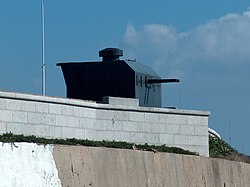Barron Plan
These defences were installed between 1948 and 1958, involving fixed batteries along the banks of the Tagus and Sado rivers and on the Atlantic Ocean side of the Setúbal peninsula.
In 1938, the Portuguese leader, António de Oliveira Salazar requested the British War Office to develop a project to defend the capital of Portugal.
[1][2][3] In 1943, Portugal implicitly ended its neutrality in World War II by transferring the Lajes airfield on Terceira Island in the Azores to the United Kingdom for use by US and UK planes to search for German submarines.
There was a high level of secrecy about the plan and its implementation and it was not until the second decade of the 21st century that information about it was declassified, even though the RAC was disbanded in 1998, by which time only two of the batteries remained active.
[5] Battery 2 was neglected but as of the end of 2023 very limited progress was being made to restore the site and open a museum and theme park devoted to coastal artillery.
The Fort of Bom Sucesso (Battery 4) is situated on the edge of the major tourist area of Belém and its future seems assured.
[4] Battery 7 on the south coast of the Setúbal peninsula is very ruined and vandalized but there were also plans in 2023 to exploit its tourism potential.




